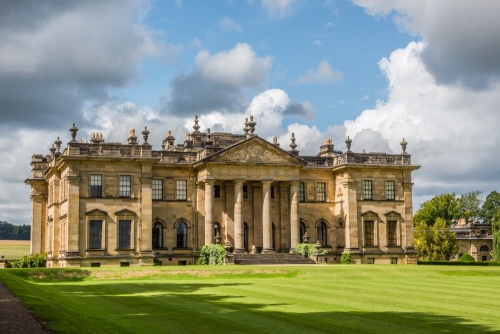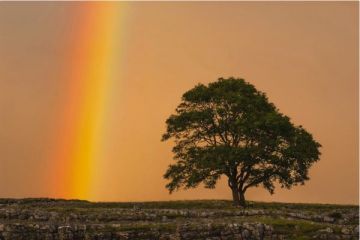
Duncombe Park house is an Italianate baroque mansion begun in 1711 by architect William Wakefield, to a design by Sir John Vanbrugh. The house was remodelled by Sir Charles Barry in the 1880s, and after WWI it became a girls school. The school ceased in 1930 and in 1988 it was 're-converted' to an elegant house.
However, it is not the house that draws most visitors to Duncombe, but the wonderful gardens and parklands that surround it.
The Gardens
There are really two gardens at Duncombe Park; one is the 14ha formal garden near the house, an oasis of green lawns, curving flower beds, terraces, and woodland walks. The other 'garden' is the extensive parkland, which is open to visitors throughout the year and offers a network of walking trails. The gardens were laid over the years 1718-1730.

The formal garden at Duncombe is the epitome of English landscape gardening that was so popular in the 18th century. Like many similar landscape gardens, you will find neo-classical temples carefully placed at advantageous spots, acting as focal points for avenues of trees or carefully planned 'surprise' views. The main temple 'follies' at Duncombe are the Doric Temple and the Ionic Temple.
The Doric Temple
The Doric Temple sits on a narrow promontory, where the river almost turns back on itself. The rich limestone soil provides a perfect habitat for wildflowers, and the temple is often surrounded by colourful blooms. This circular temple is composed of slender columns in the classical Greek Doric order, above which rises a curved dome.

Ionic Temple
From the Doric Temple, a curving terrace leads to the Ionic Temple - as you can guess, built according to the Ionic order of Greek style. This temple is quite a bit more slender than the Doric Temple, and almost seems like a garden gazebo - a very fancy one at that! The views from the Ionic Temple are marvellous, looking along the River Rye and out towards Helmsley.
A trail from the Ionic Temple leads to the Rotunda, where you will find perhaps the oldest example of a ha-ha in England. A ha-ha is a hidden ditch, generally used to create an unobtrusive barrier to livestock, bringing rural parkland closer to formal garden areas without the unpleasantness of livestock grazing in the formal gardens!
Near the Rotunda is an ash tree estimated at 148 feet high, perhaps the tallest ash in England. In another part of the park is the tallest lime tree in the country (154 feet) but this is not accessible to visitors.
To the west of the house a trail leads through lovely parkland to Rievaulx Terrace, where elegant terraced gardens with further neo-classical temples look down on the medieval ruins of Rievaulx Abbey.

The parkland at Duncombe was used as a deer park for Helmsley Castle in medieval times, but most of what we see today is the result of careful 18th-century design. Much of the park was set aside for raising herds of deer; there were separate large areas for Fallow Deer and Red Deer, and the estate sold venison locally until World War II, when all the deer were slaughtered.
The remainder of the parkland includes sloping areas near the River Rye and a special nature reserve where hardwood trees such as oak, lime, beech, and maple are managed.
Visiting Duncombe Park
The garden and parkland are open throughout the year (see the official website for current details). By contrast, the house is only open on specific bank holidays and for an annual Christmas Fair. As you can tell by the photos accompanying this article, we were fortunate enough to be able to visit the house when it was open, and to say we were impressed is an understatement.
The interiors are simply wonderful, with elegant and delicate Georgian style evident at every turn. It is a real shame the house is not open more often, but if you do get a chance to visit on an open day, do take it!
About Duncombe Park
Address: Helmsley,
Yorkshire,
England, YO62 5EB
Attraction Type: Garden
Location: Off the marketplace in Helmsley (A170). On site parking.
Website: Duncombe Park
Email: info@duncombepark.com
Historic Houses Association
Location
map
OS: SE604 830
Photo Credit: David Ross and Britain Express
HERITAGE
 We've 'tagged' this attraction information to help you find related historic attractions and learn more about major time periods mentioned.
We've 'tagged' this attraction information to help you find related historic attractions and learn more about major time periods mentioned.
Historic Time Periods:
Find other attractions tagged with:
18th century (Time Period) - Baroque (Architecture) - castle (Architecture) - Georgian (Time Period) - John Vanbrugh (Person) - Medieval (Time Period) - neo-classical (Architecture) - Sir Charles Barry (Person) -
NEARBY HISTORIC ATTRACTIONS
Heritage Rated from 1- 5 (low to exceptional) on historic interest
Helmsley Walled Garden - 0.5 miles (Garden) ![]()
Helmsley Castle - 0.7 miles (Castle) ![]()
Helmsley, All Saints Church - 0.7 miles (Historic Church) ![]()
Rievaulx Terrace and Temples - 2 miles (Garden) ![]()
Rievaulx, St Mary's Church - 2.2 miles (Historic Church) ![]()
Rievaulx Abbey - 2.2 miles (Abbey) ![]()
Gilling Castle - 3.7 miles (Historic Building) ![]()
Gilling East, Holy Cross Church - 3.9 miles (Historic Church) ![]()
















